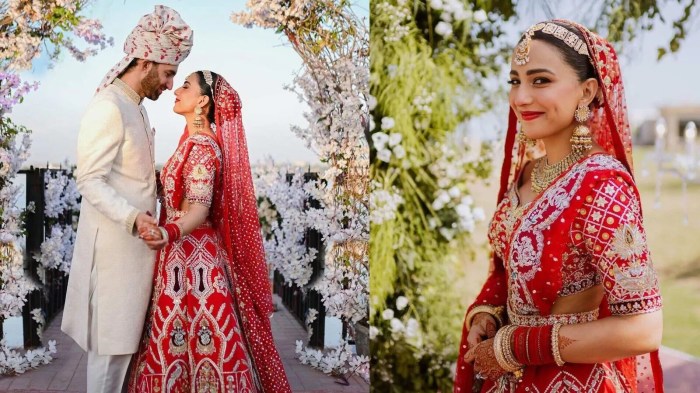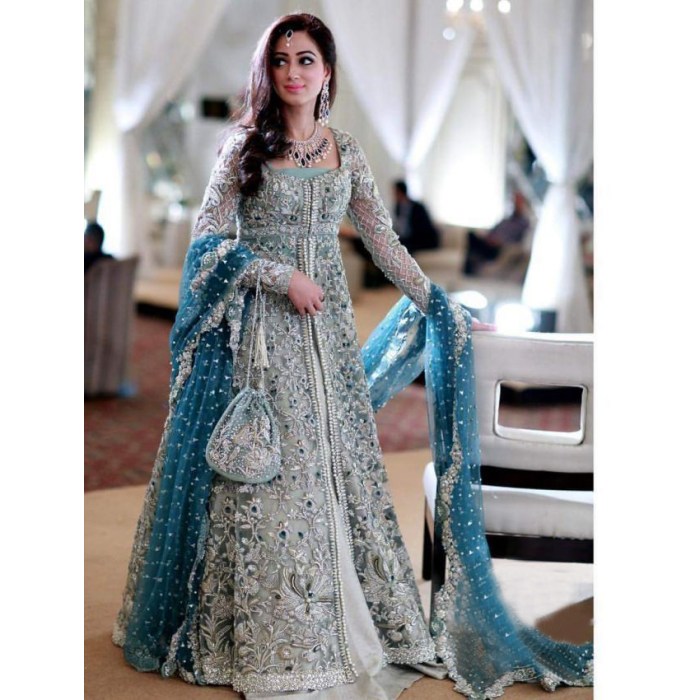Pakistani Wedding Dresses: A Comprehensive Guide

Source: livemint.com
Dresses for pakistani wedding party – Pakistani weddings are renowned for their vibrant celebrations and, of course, the stunning attire. This guide explores the diverse world of Pakistani wedding dresses, delving into the various styles, fabrics, embellishments, and styling techniques that contribute to the breathtaking beauty of these ensembles.
Types of Dresses, Dresses for pakistani wedding party
Pakistani wedding dresses showcase a rich tapestry of styles, each with its own unique charm and appeal. The choice often depends on personal preference, body type, and the specific wedding event.
| Dress Style | Fabric | Embellishments | Suitability for Body Types |
|---|---|---|---|
| Sharara | Silk, chiffon, net | Embroidery, sequins, stones | Flattering on most body types, especially those with a defined waist. |
| Gharara | Silk, velvet, organza | Embroidery, zari, mirror work | Ideal for those with a slender frame. |
| Anarkali | Silk, net, georgette | Embroidery, sequins, beading | Suitable for various body types, especially those who want to emphasize their upper body. |
| Lehenga | Silk, velvet, brocade | Embroidery, stones, gota patti | Can be adapted to suit different body types with clever draping and tailoring. |
Regional variations significantly influence Pakistani wedding attire. Punjabi dresses often feature vibrant colors and intricate embroidery, while Sindhi dresses may incorporate mirror work and traditional patterns. Balochistan’s attire is known for its bold colors and geometric designs, and Khyber Pakhtunkhwa’s dresses often display subtle elegance with rich fabrics and minimal embellishments. These regional styles reflect the diverse cultural heritage of Pakistan.
Over the past 50 years, Pakistani wedding dress styles have undergone a remarkable evolution. The influence of Bollywood and Western fashion has led to the incorporation of modern silhouettes and designs, while traditional techniques and embellishments remain integral to the aesthetic. The shift from heavy, traditional styles to lighter, more contemporary designs reflects changing trends and preferences.
Fabrics and Embellishments
The selection of fabric and embellishments plays a crucial role in defining the overall look and feel of a Pakistani wedding dress. The choice often depends on the season, occasion, and personal style.
- Silk: Luxurious, rich texture, suitable for all seasons (with varying weights).
- Velvet: Heavy, warm, ideal for winter weddings.
- Chiffon: Light, flowing, perfect for summer weddings.
- Net: Sheer, delicate, often used for overlays and embellishment.
- Organza: Crisp, stiff, lends itself well to structured designs.
Embellishments add a layer of opulence and intricacy to Pakistani wedding dresses. A wide range of techniques and materials are employed to create stunning visual effects.
- Embroidery: Includes various styles like zardozi, aari, and phulkari, each with its unique pattern and stitch.
- Sequins: Add sparkle and shine, available in various colors and sizes.
- Zari: Metallic thread embroidery, creating intricate designs.
- Stones: Precious and semi-precious stones enhance the luxurious feel.
- Gota Patti: Traditional gold and silver ribbon work.
| Season | Occasion | Color Palette |
|---|---|---|
| Summer | Mehndi | Pastel shades, bright yellows, oranges, pinks |
| Winter | Barat | Deep reds, maroons, blues, greens |
| Any Season | Walima | Ivory, cream, pastels, light golds |
Styling and Accessories
Accessories are essential in completing a Pakistani wedding dress look, adding a touch of personal style and enhancing the overall aesthetic.
- Jewelry: Traditional necklaces, earrings, bangles, and maang tikas are popular choices, with modern interpretations also prevalent.
- Footwear: High heels, embellished sandals, or traditional juttis complement the dress.
- Dupatta: The dupatta (scarf) adds a touch of elegance and can be styled in numerous ways.
Styling a Pakistani wedding dress involves careful consideration of the body type to create a flattering silhouette. For example, A-line dresses are generally flattering on most body types, while empire waist dresses can be ideal for those with a fuller figure.
- Mehndi: Opt for a lighter, more comfortable dress with vibrant colors and intricate embellishments. Accessorize with colorful bangles and jhumkas (earrings).
- Barat: Choose a rich, opulent dress in a darker shade, often with heavier embellishments. Pair with statement jewelry and elegant heels.
- Walima: Select a more subtle and elegant dress in lighter colors, such as ivory or pastel shades. Keep the jewelry and accessories more refined.
Modern Trends and Influences

Source: styleglow.com
Pakistani wedding fashion constantly evolves, incorporating modern trends while preserving traditional elements. Three emerging trends include the use of unconventional colors, minimalist designs with clean lines, and the integration of sustainable fabrics.
Contemporary Western influences are visible in the adoption of modern silhouettes, such as mermaid or sheath dresses, which are adapted to incorporate traditional Pakistani embellishments. This fusion creates a unique blend of cultures.
Social media and fashion blogs have significantly impacted Pakistani wedding dress styles. These platforms showcase diverse designs, inspire new trends, and allow for wider accessibility to fashion information. The visual elements often include detailed close-ups of embroidery, unique draping techniques, and innovative color combinations.
Budget Considerations
Finding an affordable yet elegant Pakistani wedding dress requires careful planning and resourcefulness. Sourcing fabrics directly from wholesalers and opting for simpler embellishments can help reduce costs. Tailoring a dress from a skilled but less expensive tailor is another option.
Creating a budget involves considering fabric costs, embellishment expenses, tailoring fees, and the cost of accessories. A detailed breakdown helps in managing expenses effectively.
Choosing the perfect dress for a Pakistani wedding party often involves considering vibrant colors and intricate embellishments. The level of formality can vary, so researching appropriate attire is key. For inspiration on elegant yet respectful guest attire, you might find browsing options for arab wedding dress guest helpful, as similar considerations of cultural sensitivity and dress codes apply.
Ultimately, selecting a dress that reflects both the celebratory nature of the event and personal style is paramount for a Pakistani wedding.
Ready-to-wear dresses are generally less expensive than custom-made ones, but offer less flexibility in terms of design and fit. Custom-made dresses allow for personalized designs and perfect fit but come with a higher price tag.
Essential FAQs: Dresses For Pakistani Wedding Party
What is the average cost of a Pakistani wedding dress?
The cost varies greatly depending on the fabric, embellishments, and whether it’s custom-made or ready-to-wear. Prices can range from a few hundred to several thousand dollars.
How far in advance should I start looking for a Pakistani wedding dress?
Ideally, begin your search at least six months before the wedding to allow ample time for alterations, customizations, and potential delays.
Where can I find affordable Pakistani wedding dresses?
Explore online marketplaces, local boutiques specializing in South Asian clothing, and consider renting a dress instead of buying.
Can I wear a Pakistani wedding dress to a different cultural wedding?
While you certainly can, it’s advisable to consider the cultural context and dress modestly and respectfully, perhaps opting for a less elaborate design.
